Less than forty kilometers from Papeete, between mountains and lagoon, the Domaine d’Atimaono offers a huge privileged space, ideally located on the west coast of Tahiti Nui… And it is on this historic land that the Moux distillery, which produces Tamure rums, the oldest brand of Polynesian rum and yet the least known, is located.
Indeed, we’ve been hearing a lot about Mana’o, Manutea, and even Pari Pari rums since 2015, but Tamure rums have been around since 1991! Because we don’t break tradition, I’d like to invite you to serve yourself a good maita’i and settle down in your hammock as “Cuckoo” by Teten Toofa plays in the background, because I’m taking you to meet David Moux for a trip to the heart of the Pacific Ocean!
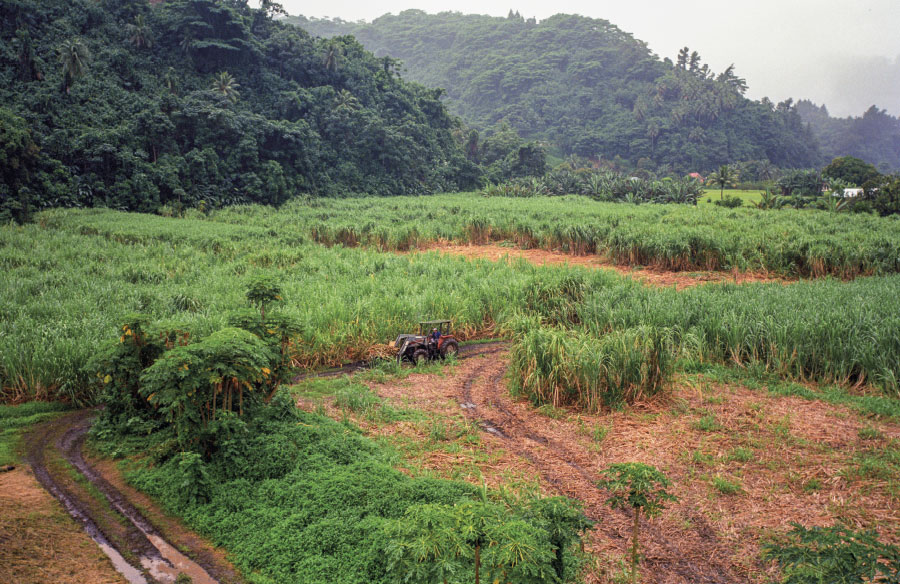
Historically, tô (“sugar cane” in Tahitian) has been present on Fenua (Tahitian expression meaning “territory” and thus designating Tahiti and French Polynesia more globally) since more or less 300 years AD, notably with the famous O’Taïti variety that will be exported around the world by the famous navigators Louis-Antoine de Bougainville, James Cook, and William Bligh.
However, it was not used to make rum until the 19th century! Indeed, following the implementation by the government of agricultural premiums for the planting of sugarcane, the island of Tahiti began to see large plantations grow in 1857, and the site of
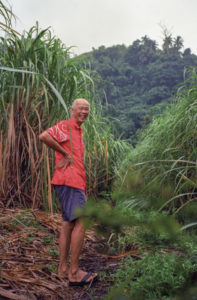
Atimaono is one of the main cradles. Also known as “Eugenie Land” in honor of Empress Eugenie de Montijo – wife of Napoleon III – the Atimaono estate is also the base of the Chinese community in Tahiti.
In 1864, out of approximately 4,000 hectares of land, 1,400 were dedicated to cultivation, and to take care of the 1,000 hectares of cotton plantations as well as 150 of coffee, 150 of sugar cane and the rest of the fruit, the Imperial Commissioner of the Society Islands authorized the migration of 1,000 Chinese who were fleeing the warlords. They served as laborers until the cotton industry went bankrupt in 1867.
The cultivation of sugar cane then took over and Atimaono was transformed into a sugar estate until 1966 when a businessman decided to put an end to the Papara rum factory in order to build a golf course in the early 1970s…
David Moux, creator of the eponymous distillery, is a descendant of these growers from China. Given his family’s past, David has always lived with cane around him, but the Tāmūrē adventure begins in a rather peculiar way… In 1980, Yann, David’s eldest son, had a high fever. So, to bring down the temperature, David’s mother-in-law resorts to “rā’au Tahiti,” traditional Tahitian medicine.
Through a decoction made of sugar cane juice and local plants, the pains disappeared and David saw it as a sign. In 1981, while working at the Centre d’Expérimentation du Pacifique (CEP), he decided to plant 10 acres of sugarcane in the Tīpaeru’i valley with varieties gleaned here and there from various private gardens.
Two years later, nature was unleashed and the cyclone Weena hit French Polynesia and completely destroyed the plantation. Dejected and at the end of his strength (David was a quantity surveyor at the CEP during the day and worked on his canes at night), he gave up the project… But he didn’t count on the magic of nature because the shoots resurfaced and the first harvest was possible in 1984!
From then until 1989, the canes will only be used to make juice to be sold fresh on the market of Papeete located a few kilometers away. It is really from 1988 that the idea of making rum began to mature… In the meantime, the plantation increased from 1000m² to 4 hectares and was transferred from Tīpaeru’i to the commune of Papara. Right next to these 4 hectares of cane are 13 hectares of fruit (pineapple, papaya, lemon, soursop, grapefruit, maracuja, and ginger) which are also sold as juice at the Papeete market.
In 1990, having more cane than he needed to make juice, David took the plunge and wanted to distill in order to avoid waste. Problem: everyone around him thought he was crazy and he had no idea how to do it…
So, with determination and a thirst for learning, David trained himself with the help of books and experiments with a home-made still. In 1991, anxious to increase the quality of his distillates, David boldly left for Marie-Galante to follow a training course with Dominique Thiéry and the famous Bielle distillery. Back on the fenua with precious advice and knowledge, David imported an iron still from Brazil, continued to perfect his technique, and proudly marketed his first bottle in 1992.
The Polynesian reception for Tāmūrē, the very first indigenous, agricole and artisanal rum, was quite positive. “Tāmūrē is the name of a traditional Polynesian dance,” exclaims David. “I wanted to call my rum that because after you drink it, you feel like dancing!” he continued with a mischievous eye.
“My wife and I wanted something that recalls the joy of living, conviviality, and authenticity, like what rum (pure juice) represents,” he concludes. Five years later, in 1997, after many financial sacrifices and hard work, the distillery was modernized a little more thanks to a mill also from Brazil. At the same time, a second plot of cane was also planted in Papeari, bringing the total to about 17 hectares of cane.
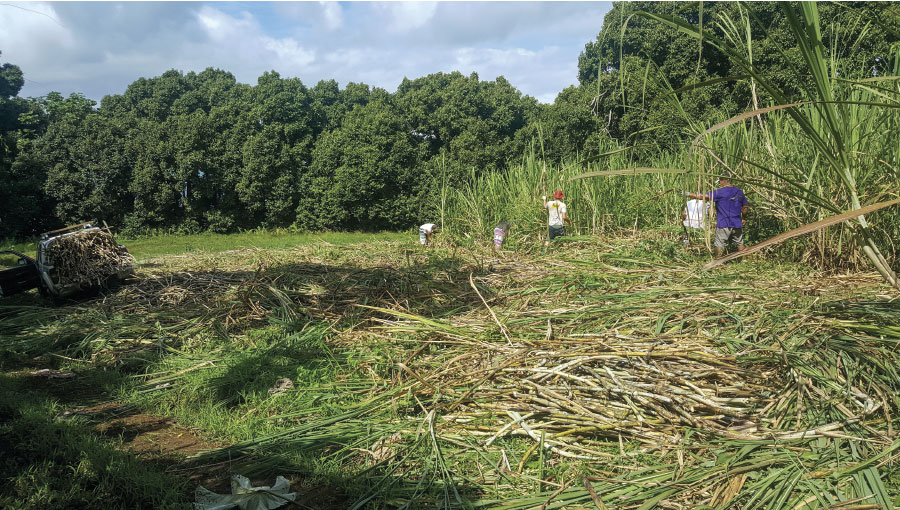
On the cane side, two varieties of tō are mainly grown but are not really known. There are two vernacular names: Vaihī (“Hawaii” in Tahitian) and ‘Ofe (“bamboo”), the origins of which are unknown…
The genotyping of Polynesian cane is one of the projects planned by the Syndicat de Défense de l’Indication Géographique du Rhum Agricole de Polynésie Française. As for the terroir, it will not surprise anyone that the soil is mostly of volcanic origin. That said, the two plots are subject to two different climates. The Papara parcel, which is located on an old swamp with silty soil and a very low pH, is surrounded by a mountain range and the hills of the valley.
The soil does not require liming or irrigation and is rather fertile thanks to a high rainfall. The Papeari plot benefits from an arid climate, lots of sun, and acidic soil. The wind and the sea spray sweep the canes very regularly. Neither plot is treated with chemical fertilizers or pesticides.
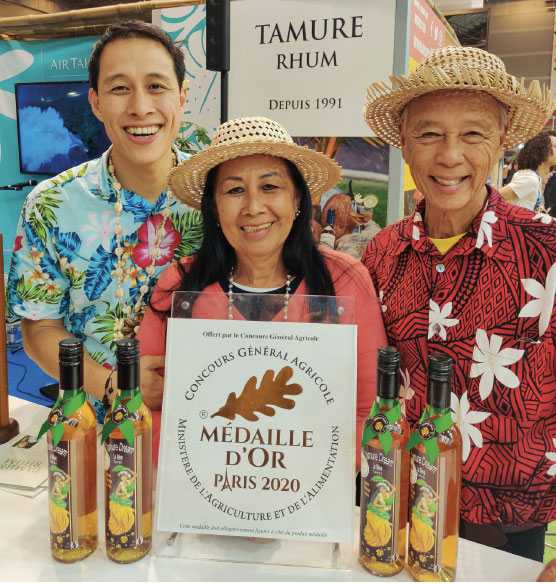
The average Brix of the canes is around 16°B with a yield of more or less 80 tons per hectare. The canes are harvested throughout the year even if a large part is harvested during the dry season, June to October. Once the canes are cut with a harvester, they are transported by truck to the distillery to be crushed in a single pass without adding water.
The vesou harvested is put in fermentation in one of the three stainless steel tanks for a fermentation of approximately 90 hours without acidification of the must. Distillation takes place according to the needs and desires, using two copper stills heated over a wood fire: a Brazilian still with a capacity of 10 hectoliters, or by column still with 25 trays and a direct boiler customized by David himself.
The heart of heating flows around 70%, as for the column, the rum comes out rather around 80%. The resulting distillate will be reduced with a drop of Tahitian spring water and then brewed for 6 months until it reaches 56% for the “premium” white. The rest of the range is composed of a more basic white rum at 47%, a vanilla white at 47%, a white at 38%, two browns (one at 38% the other at 45%) “tinted” with caramel, 4 punches at 22% (Ginger, Passion, Pineapple and Vanilla), a 45% Puna’auia wild orange liqueur, a 3 year old vanilla flavored at 47% and a 12 year old blend at 45%. Note that in the past, Tāmūrē has marketed two single casks for bottler “Rock’n’Rhum,” one 6 and one 15 year old, all aged in ex-bourbon barrels.
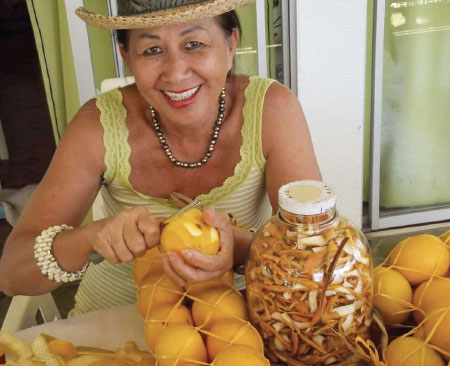
For the moment, the rums are elaborated via a mixture of canes but monovarietals have already been distilled last year (and to have tasted them, it is frankly very good!). The future will tell us if they will be released as raw stills or in reduced versions. Unfortunately, with the Covid-19 crisis, the investments for the purchase of barrels and the planting of new plots are on stand-by for the moment…
Obviously, as you can imagine, given the size of the structure, whether it’s the fruit workshop part for the punches or the packaging, everything is done entirely by hand with the help of Hélène (David’s wife), Rony (their youngest son) and the 9 employees. With a little over 10,000 bottles per year, the production of Tāmūrē rums remains confidential and sales are mainly on the local market, although Youk, one of David’s sons, has moved to Paris in order to distribute some bottles more easily in France. Prices in France vary from 30 to 55 € depending on the desired vintages.
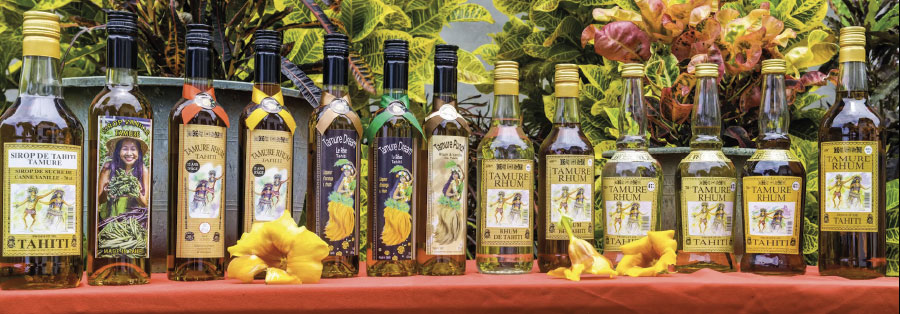
From now on, alongside Mana’o, Manute’a and Domaine de Pari Pari, you’ll have to count without a doubt on Tāmūrē rums to represent French Polynesia with dignity! At 73 years old and with his pioneering status, David is highly respected by his fellow rum makers. In fact, the four distilleries came together in May 2020 to form a union since September, with Marotea Vitrac as its president.
The steps to create a Geographical Indication will not be long in coming… This appellation will protect, enhance and ensure the future as well as the Polynesian know-how not only at the national level but also at the European level. Passion, technique and invitation to travel, since 2015 the rums of Fenua have been demonstrating their qualities by collecting more and more medals at the Concours Général Agricole de Paris where they have recently been integrated and are more and more appreciated by connoisseurs in France. However, they still have two significant obstacles in their evolution: although French, French Polynesia is a COM (Collectivité d’Outre-Mer) and is not part of the European Union (associated territory).
Therefore, the use of the term “agricole” is prohibited, unlike their rum colleagues in Martinique, Guadeloupe, Guyana or Reunion. The other problem, and not the least, is directly related to taxation because unlike the DROM (Department and Region of Overseas), the COM do not benefit from the benefits of quota, and therefore pay full pot on the various taxes and excise.
This surplus is automatically passed on to the consumer’s wallet. Let’s hope that the Syndicat de Défense can negotiate these two points in addition to ensuring a perennial future for the Pacific cane/rum industry… With these hopes, all that remains is for me to wish Tāmūrē rums a long life as well as, if you happen to come across it, to wish you an excellent tasting. Manu’ia!
➔ Rum Tamure – Moux Distillery
PK 39.800 route de la Carrière, côté montagne
98712 Papara
www.tamurerhum.com
